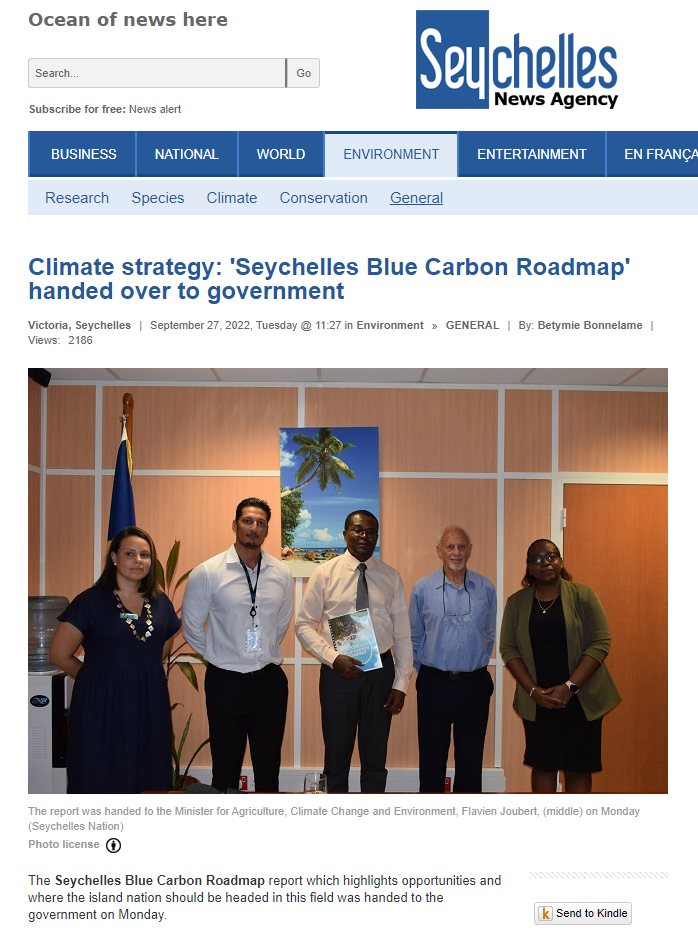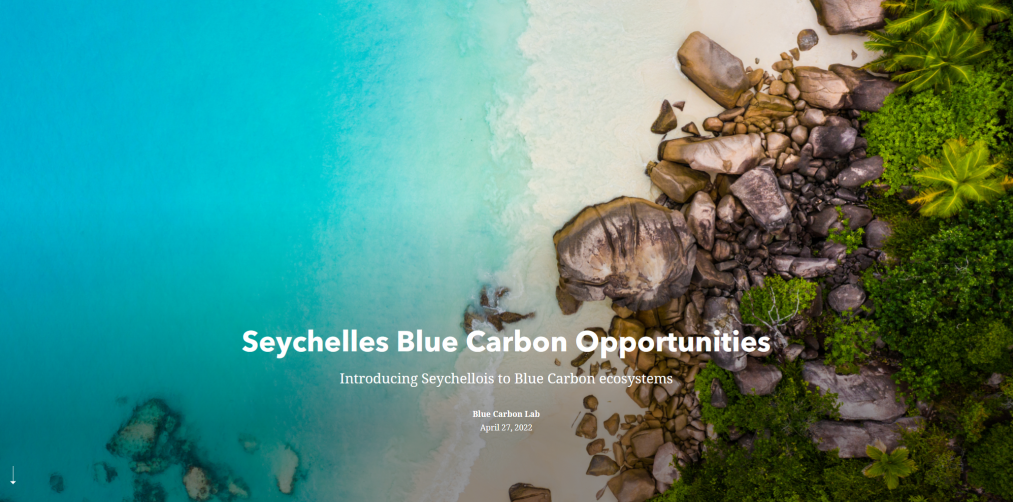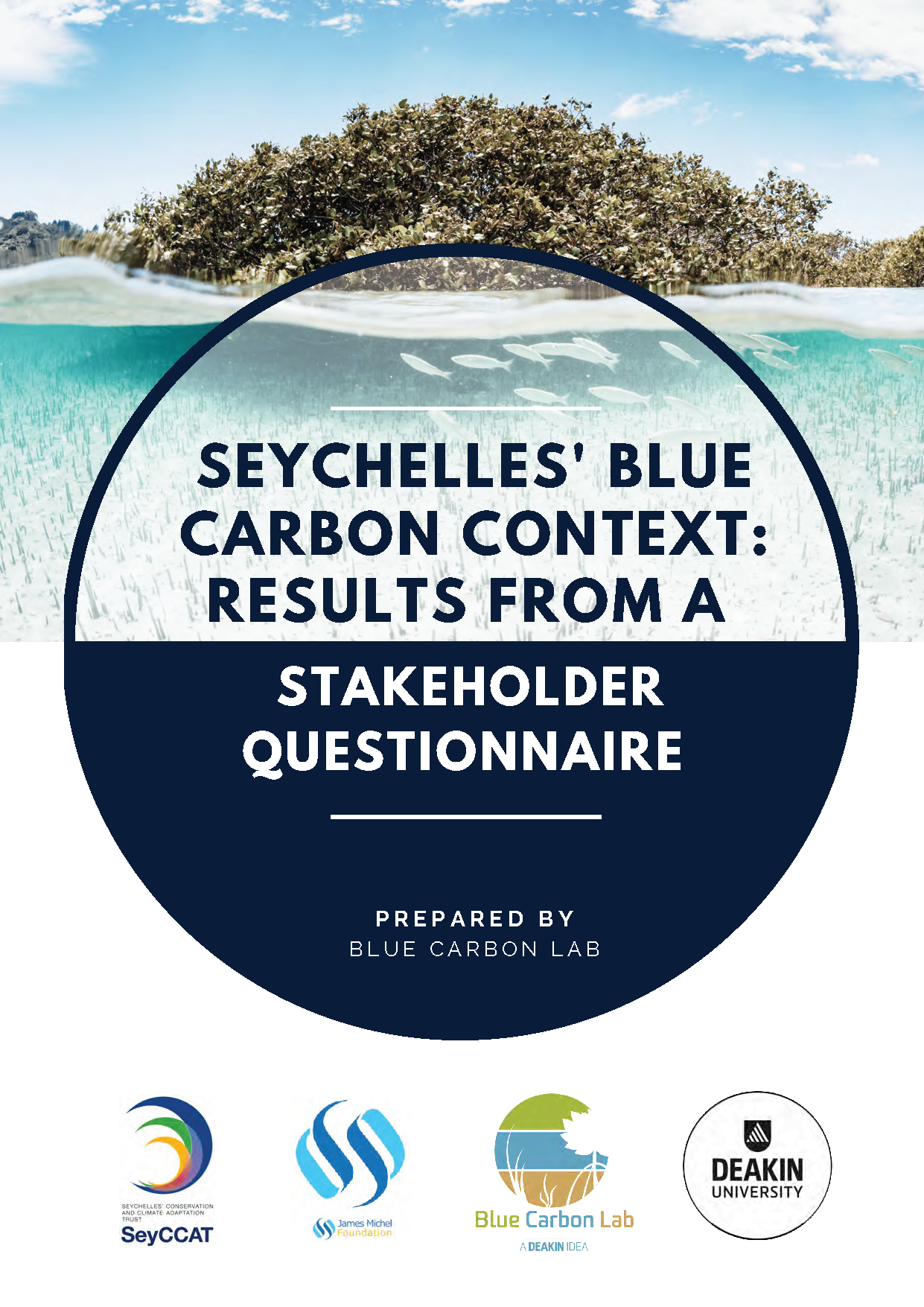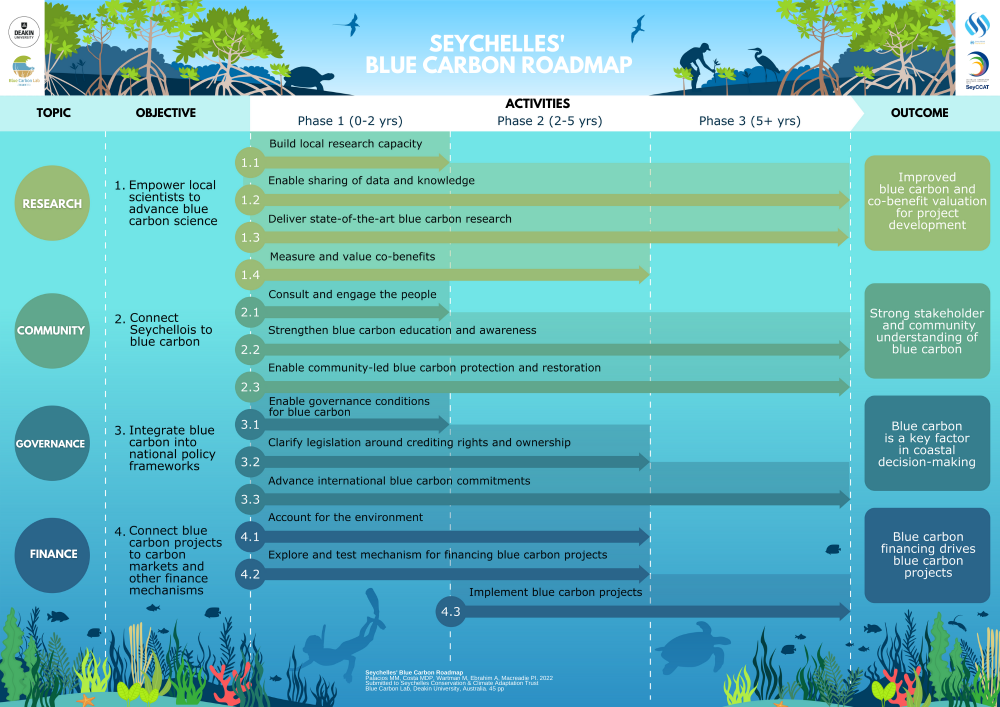Seychelles Blue Carbon
Background
Seychelles, classed by the United Nations as a Small Island Developing State (SIDS), has a total landmass of 459 km2 and an Exclusive Economic Zone of 1.35 million km2. Seychelles’ residents rely heavily on marine tourism and fishing revenue, however coastal wetlands have declined dramatically as a result of coastal development, and face added pressures with future sea level rise, increased storm surge, and salt water inundation.
Conservation Finance
Seychelles used the world’s first “debt for nature swap” and “blue bond” to support the conservation of its marine ecosystems.
Protection
Seychelles
pledged to protect
at least 50%
of its seagrasses
and mangroves
by 2025.
Extent
Blue carbon ecosystems in Seychelles cover more than 145,000 hectares.
Seagrass
Seagrass beds account for 99% of the blue carbon extent in Seychelles.
Mangroves
Mangrove forests cover 1,700 ha, with more than 80% of them located within the Aldabra Atoll.
Carbon stock
Seychelles’ blue carbon ecosystems hold over 17 million tonnes of organic carbon (or over 62 million tonnes CO2e).
Every year, Seychelles Blue Carbon ecosystems can capture more than 200,000 tonnes of organic carbon, equivalent to more than 60% of Seychelles’ annual CO2 emissions.
Seychelles blue carbon programs
Program 1: Exploring blue carbon opportunities
In partnership with the James Michel Foundation, the Blue Carbon Lab developed a “Roadmap to Blue Carbon opportunities in the Seychelles” funded by a 2-year Blue Grant from SeyCCAT. This project explored Seychelles’ Blue Carbon future, by developing a first-pass assessment of potential Blue Carbon opportunities in Seychelles and building local capacity on Blue Carbon through a technical workshop. Accounting for the ocean’s carbon offsetting capacity can help Seychelles remain a net carbon sink and achieve its Nationally Determined Contributions (NDCs).
Program 2: Mangrove carbon stock assessment
Blue Carbon Lab is leading a field-based blue carbon assessment for mangrove systems in the inner granitic islands and Aldabra/Cosmoledo Atolls of Seychelles to derive and analyse local-scale field data on above-ground biomass and soil organic carbon. Initiated by the Ministry of Environment, Energy and Climate Change (MEECC) with financing from Third South West Indian Ocean Fisheries Governance and Shared Growth Project (SWIOFish3) the results of this assessment will support the inclusion of mangrove ecosystems into Seychelles’ NDCs for the United Nations Framework Convention on Climate Change (UNFCCC).
Storymap
Submerge yourself into Seychelles’ mangrove forests and seagrass meadows through this interactive Storymap. Designed to raise awareness on the importance of blue carbon for climate mitigation, this is a great resource to explore Seychelles’ blue carbon opportunities and explore local initiatives advancing blue carbon science and raising community awareness.
Project outcomes
Click the links below to download the documents. Feel free to use them and share them with the correct attributions.
Literature review: Blue Carbon Research in the Tropical Western Indian Ocean
The research identified 131 studies examining the biomass or carbon stored in the Western Indian Ocean’s (WIO) mangroves and seagrass beds. Of these, 101 contained unique datasets, which were used in the study, 82 were based on mangrove ecosystems and 49 explored seagrass meadows, despite their higher distribution extent. This is likely to be because of mangrove’s higher carbon storage potential and easier access to sites and sampling. Almost half of the studies were published in the last 10 years, showing an increase in blue carbon research interest. Most studies were conducted along the mainland East African coast and only 4 in the Seychelles: 1 on mangroves, 3 on seagrass meadows. The main conclusions from the report:
Stakeholder Questionnaire: Blue Carbon Context in Seychelles
This report depicts the results of a stakeholder questionnaire intended to solicit local knowledge on the current social, political, ecological and scientific context of blue carbon ecosystems in Seychelles (i.e., mangrove forests and seagrass meadows). To achieve this, the questionnaire was distributed among stakeholders working in close connection to Seychelles’ coastal ecosystems. In total, 103 stakeholders from 56 organisations responded the questionnaire. Our analysis of the questionnaire identified key points about the local attitudes, knowledge, and frameworks around Seychelles’ coastal ecosystems.
Roadmap: Seychelles’ Blue Carbon Roadmap
Seychelles’ Blue Carbon Roadmap sets a long-term path to establish a nation-wide, evidence-based program geared towards the protection and restoration of blue carbon ecosystems for climate change mitigation and adaptation. Developed by BCL in collaboration with James Michel Foundation, the Roadmap proposes a series of social, scientific, governance, and financial actions that should be implemented over the next years.
Report: Blue Carbon Assessment for Mangrove Systems in Seychelles
This report has been prepared for Seychelle’s Ministry of Agriculture, Climate Change and Environment (MACCE). The assessment and recommendations were based on results of an extensive fieldwork campaign by a team of local researchers, led by Seychellois consultant Dr Barry Nourice. Blue Carbon Lab made several recommendations on priority areas for continued advancement of mangrove research in Seychelles, including empowering local scientists and setting up a monitoring program to assess the risks of ecosystem degradation. Next steps for protecting Seychelles’ mangroves should include quantifying the ecosystem services provided by mangrove forests.
Selected Media and Outreach
- Mangroves Seychelles’ blue carbon eco-system (Seychelles Nation, October 2022)
- 7 pm news (SBC, 30th September 2022)
- 7 pm news (SBC, 26th September 2022)
- Climate strategy: ‘Seychelles Blue Carbon Roadmap’ handed over to government (Seychelles News Agency, September 2022)
- Blue Carbon Roadmap: Towards capitalising Seychelles’ rich blue carbon potential (Seychelles Nation, September 2022)
- Roadmap ready for protecting blue carbon ecosystems in Seychelles, says James Michel Foundation (Seychelles News Agency, July 2022)
- How much blue carbon does Seychelles have? Local experts work on monitoring and awareness, (Seychelles News Agency, April 2022)
- Roadmap to blue carbon opportunities in Seychelles (Seychelles Nation, April 2022)
- First Blue Carbon study for Seychelles (Seychelles Nation, February 2020)
- New Grant: Seychelles’ Roadmap to Blue Carbon Opportunities (BCL, February 20220)
- Roadmap to Blue Carbon opportunities in the Seychelles, (SeyCCAT)
- Seychelles Blue Carbon Journey (SeyCCAT)


Funding & Program Partners
This work is led by the Blue Carbon Lab. The Blue Carbon Roadmap project was funded by SeyCCAT (Seychelles Conservation and Climate Adaptation Trust) and done in collaboration with the James Michel Foundation. The mangrove carbon assessment project is funded by SWIOFish3 (World Bank) and is being done in collaboration with the Ministry of Agriculture, Climate Change and Environment and the Global Environment Facility (GEF).







